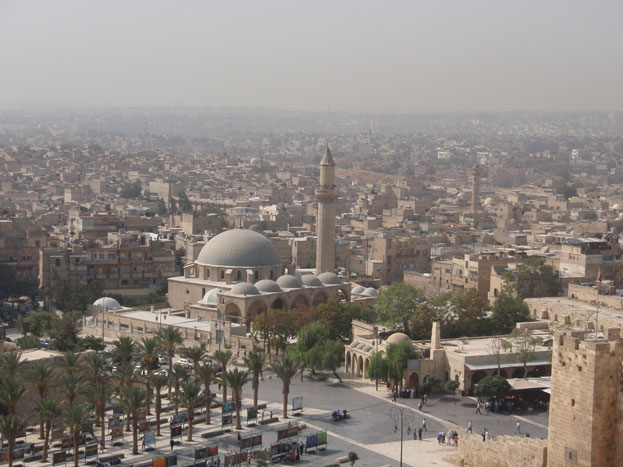The souks of Aleppo are among the longest in the world. The Ancient City of Aleppo is a UNESCO World Heritage site that used to draw tourists from all over the world, a magnificent maze of narrow streets and shop galleries carved in old stone. Today, approximately 70 % of the Ancient City of Aleppo has been destroyed, ravaged by shelling from Bashar al-Assad's government, the guerrilla warfare that took place inside and the ensuing fires. More than 1,200 shops have been burned to the ground.
Want to read UNESCO Daily News Updates? Click Here!!!
The Ancient City Crushed
 The remaining galleries are filled with debris; the air with dust. The sound of mortars crushing the stone of the Ancient City can be heard in the background. It is in this nerve-wracking atmosphere that members of the Osama Ben Zaid Katiba (Brigade) of the Free Syrian Army (FSA) perform their daily routine.
The remaining galleries are filled with debris; the air with dust. The sound of mortars crushing the stone of the Ancient City can be heard in the background. It is in this nerve-wracking atmosphere that members of the Osama Ben Zaid Katiba (Brigade) of the Free Syrian Army (FSA) perform their daily routine.In one of the galleries -- which in this ambiance are akin to an underground cave -- about 20 fighters are stationed. It is the main post of the Katiba, with several smaller outposts of three or four fighters scattered around this part of the Ancient City, behind the Umayyad Mosque, the Great Mosque of Aleppo.
If the streets of the Ancient City are clear of soldiers of Bashar al-Assad, the FSA still has to endure the pressure of the snipers stationed at the mosque and in the citadel, as well as continuous shelling, which further damages the historical site.
The citadel remains one of the most formidable Assad strongholds in the city, seemingly impossible to take due to its high ground. It was also damaged by mortar fire at the beginning of the battle for Aleppo, when regime forces drove the rebels out.
The Great Mosque, where the army keeps tanks, snipers and RPGs, is the site of fierce battles for the Osama Ben Zaid Katiba – the only place where they directly engage government forces. Over the past two weeks, they retook it twice and lost it.
However, Yusuf Mansur, the leader of the brigade, says they do not want to attack the mosque directly again for fear of damaging it even further.
TheText
"It is a historical place, and a holy place. We cannot attack it directly. We cannot risk destroying it," he says.
Mansur, 39, defected from the Assad regime three and a half months ago, shortly after the beginning of the battle for his city. He leads the Katiba and makes sure everyone keeps focused.
"It's easy to lose one's mind in the galleries. They are narrow and oppressive. I want to make sure that the boys keep their discipline. We are not afraid, for we fight with Allah, but we are bored and oppressed. This must be kept in check," he explains.
And indeed, despite the tense atmosphere -- the ceiling of the souk shakes and dust fall each time a mortar hits –- the fighters keep to a daily routine.
Sitting in front of a shop-turned dormitory, Bahjat, 18, cleans several AK-47s. Next to him, Abdel, 20, prepares lunch for the Katiba (hummus, rice and pita bread), while Abdel Nasser, 42, kneels for prayer. Other fighters stand guard at the four entrances of the gallery.
Mansur and Abu Farez, 40, his second in command, drink tea and make plans to dislodge a government sniper in a nearby street.
Snipers make moving around the souks dangerous, and Abdel will have to sprint across several streets in order to deliver food to other outposts closer to the mosque. On his way, he will pass several galleries that have been completely consumed by fire.
Mansur is particularly pleased with his Katiba, as it counts many civilians that took up arms with the uprising -- several university students, a store clerk, an art dealer. It also has a high number of defectors who have had extensive military training. They are mostly from Azaz, Marea and other cities in the north.
Amer, 21, defected from the security forces when the war reached Aleppo. "I did not want to kill my people. In the army, there was no TV, no radio, and no newspapers. Only the order to kill terrorists. But I knew they were not terrorists; they were my brothers."
Beyond the pressure of living in a confined space, along with the shelling, snipers and sporadic clashes, there is the added responsibility of having to preserve the souks from complete destruction.
"It pains me to see our heritage disappear in flames," says Mansur, adding that the Syrian army does not care if the souks burn. "When there is a fire, Assad's soldiers keep us under constant pressure on the front and with shelling so that we cannot put it out."
The Katiba leader believes that the Syrian army wants the fires to spread to kill or smoke out the rebels, and also so that the rebels are blamed for the fire and therefore lose popular support.
With the recent rebel advance in Christian and Kurdish neighbourhoods, the citadel and mosque remain some of the most important government strongholds in the centre of town. It is unlikely that the rebels would be able to take them without doing further damage to the historical riches of the city.










No comments:
Post a Comment